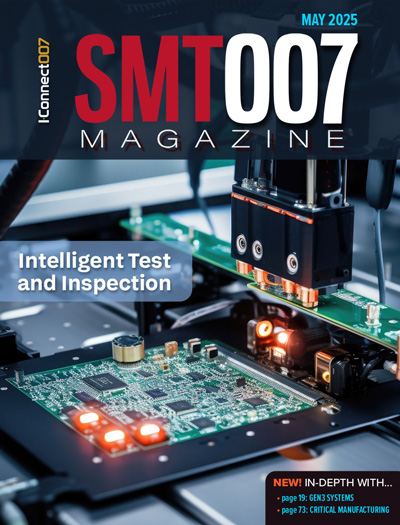-

-
News
News Highlights
- Books
Featured Books
- smt007 Magazine
Latest Issues
Current Issue
What's Your Sweet Spot?
Are you in a niche that’s growing or shrinking? Is it time to reassess and refocus? We spotlight companies thriving by redefining or reinforcing their niche. What are their insights?

Moving Forward With Confidence
In this issue, we focus on sales and quoting, workforce training, new IPC leadership in the U.S. and Canada, the effects of tariffs, CFX standards, and much more—all designed to provide perspective as you move through the cloud bank of today's shifting economic market.

Intelligent Test and Inspection
Are you ready to explore the cutting-edge advancements shaping the electronics manufacturing industry? The May 2025 issue of SMT007 Magazine is packed with insights, innovations, and expert perspectives that you won’t want to miss.
- Articles
- Columns
- Links
- Media kit
||| MENU - smt007 Magazine
Consistent PCB Traceability with Data Matrix Symbols
December 31, 1969 |Estimated reading time: 3 minutes
By Laura Hoffman, Microscan
To improve quality control, traceability, and throughput on their test adapters, an electronic components and modules manufacturer implemented miniature data readers inside inspection systems. These vision systems have to read barcodes and cope with challenges posed by shiny PCB materials, limited space, and zero-defect/high-reliability end-product standards.
Zollner Elektronik is a system service provider of electronics manufacturing services. The company performs production and service of electronic, mechanical, and inductive components. Zollner Elektronik manufactures products, such as modular electronic PCBs, in 13 international facilities. An important aspect of its production process is the automatic final inspection systems for safety-related assemblies, such as PCBs for the automotive sector. The company's quality control (QC) and inspection procedure separates out rejected items before they reach dispatch and the process is documented for each PCB produced.
At Zollner Elektronik AG, PCBs are tested prior to shipment so that only faultless products reach the customer. To cope with the minimal space available in the test adapters as well as the difficulties caused by brightly polished surfaces, a small barcode reader was determined to be necessary. Zollner Elektronik consulted WI-SYSTEME GmbH, specializing in traceability solutions such as automatic marking and barcode reader integration, on the selection of the appropriate reader for their requirements. The electronics manufacturing company implemented a data-tracking vision system to improve traceability in the test area. A high-performance miniature imager* for data tracking handles the control procedure, chosen for small size and reliable performance.
Quality Control ProceduresTo guarantee consistent traceability of PCBs from the material charges used for the components through to correlation of the inspection data the company identifies the PCBs using Data Matrix symbols. Data Matrix symbols are two-dimensional matrices consisting of black and white squares arranged in either a square or rectangular pattern. The pattern represents text or other data that identifies the component and its relation to an assembly, product run, and even client. In factory-wide traceability systems, these are decoded in all stages of production and saved in a database after the process and material data are collected. For Zollner Elektronik, this allows confirmation that upstream inspection processes are completed successfully before the start of testing, as well as restricting the number of repeat tests and permissible remedial actions required.
The quality control procedure is performed in test adapters.** In the test adapter systems, voltage is applied to the PCBs and defined routines are executed and documented. A reject component gate ensures that imperfect components are eliminated from the process chain safely. For traceability purposes, and for reading the Data Matrix, a 2D reader was needed to meet Zollner's multiple requirements.
ChallengesThe PCB assembly carries a 15-mil 12 × 12 Data Matrix barcode, which is applied to a label made of polypropylene (PP) foil by means of thermo-transfer printing. The brightly polished surface of the foil poses strict challenges for the data reader implemented in the traceability system. Furthermore, the reader had to fit the restricted space availability of the test adapter in this situation.
The WI-Systeme technical department proposed imager systems with flexible programming and setup, a mounting size that would permit integration into the test adapter system without impeding the handling of the test specimens when inserted, and strong image processing and focus capabilities. A second imaging system with a 90° mirror was mounted in a reject component gate so that the code of rejected assemblies was verified and provided confirmation that all imperfect components were eliminated from the process chain.
In addition, the brightness of the PP foil poses strict requirements on the integrated illumination for the imager. In this situation, select a system suited to imaging with stationary objects; one that fits into the restricted space of the inspection system will offer considerable freedom in operating clearance.
An autofocus capability facilitates quick changeover, and reliable decoding prevents unnecessary downtime due to reading problems. Faster product changeovers and improved uptime result in higher-throughput at the tester stations, fewer bottlenecks to the manufacturing process, and the boosts to output and bottom line that coincide with these developments.
ResultsWith implementation of the miniature data readers in the test adapter system and in the reject component gate, Zollner Elektronik experienced better traceability of PCBs. Implementing advanced vision systems as process and quality control tools, the company was able to ensure that only successfully inspected components are delivered to their customers.
*The system implemented is a Quadrus MINI®.** Twister Adapter test adapters are supplied by ATX Hardware GmbH.
Laura Hoffman, director of marketing, MICROSCAN, may be contacted at info@microscan.com, www.microscan.com. Information provided in this article originally appeared in Germany in SPS Magazine.


